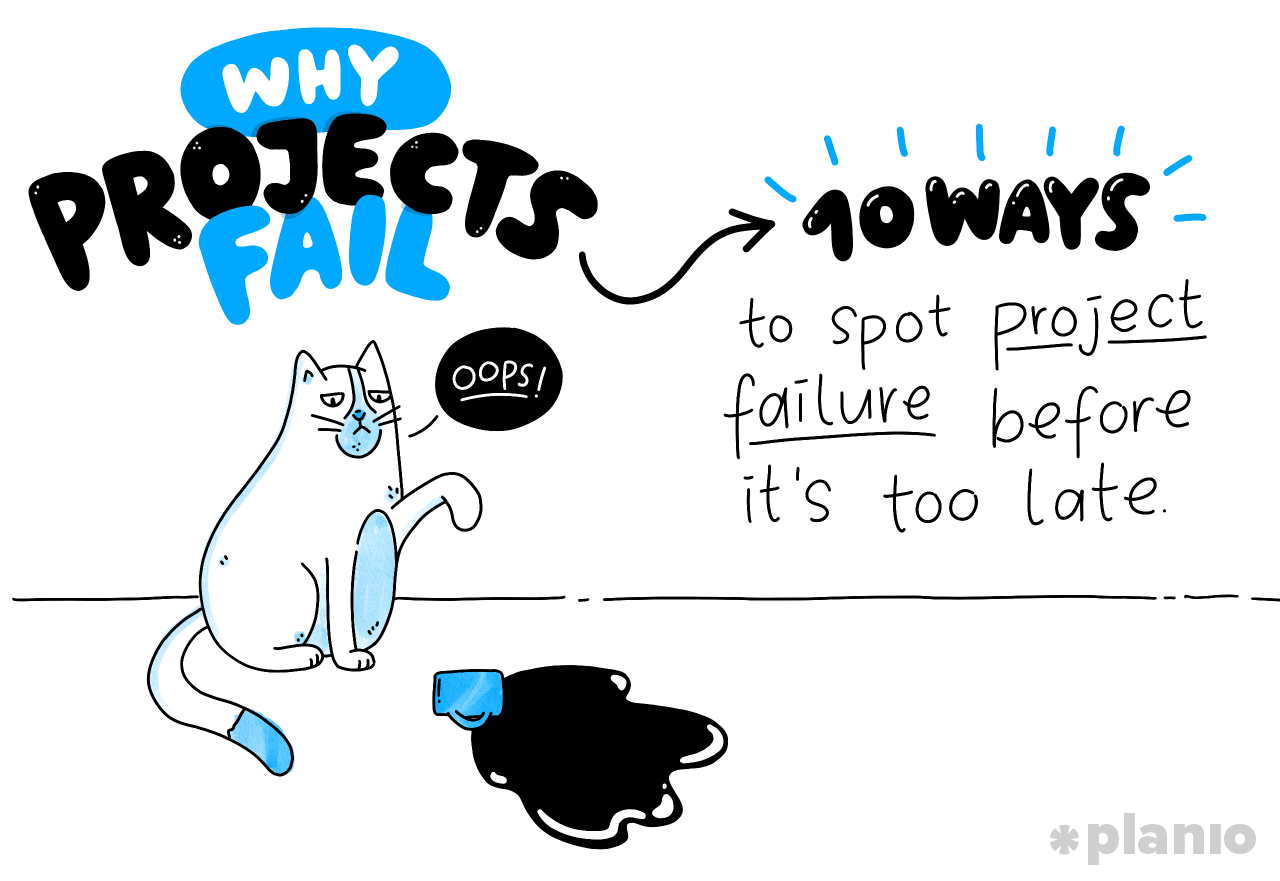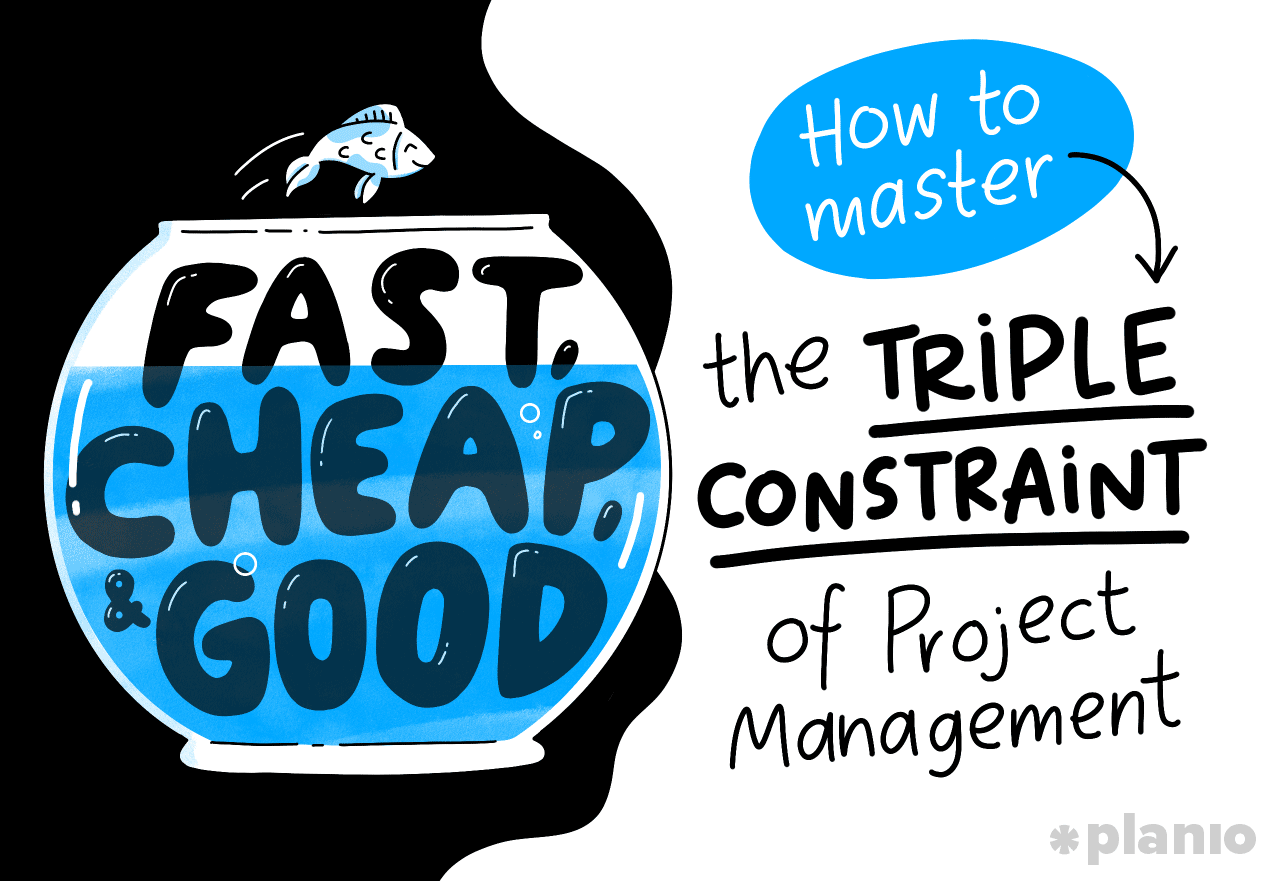The Pyramid Principle and other frameworks for effectively pitching your projects

Pitching projects and building influence with stakeholders and executives is an essential part of successfully managing projects. But, while project managers have tons of skills, they’re rarely good at being salespeople.
The issue often comes down to a Goldilocks problem with information. If you focus too much on all the risks, context, and background information, you’ll put your audience to sleep before the big reveal. But move too quickly and gloss over details and you’ll come across as unprepared or naive.
So how do you strike the right balance? It comes down to choosing the right pitch framework for your subject and audience.
If you want to take the next step on your career path, you need to learn how to pitch in any situation. In this guide, we’re going to run through some of the most powerful pitching templates, from the more structured pyramid principle to the lightning fast elevator pitch.
Why do project managers need to learn how to pitch?
Pitching helps you build influence with the people that matter, whether that’s a client or a stakeholder. When it comes to executives, learning how to pitch clearly and confidently demonstrates a deeper understanding of wider business goals and how your work contributes to them.
But, many project managers complain that executives see them as ‘that person who’s always sending me meaningless status reports’. It can feel like they don’t see the value you bring and it may even feel like they see you as a roadblock to real progress.
The key is to think differently about your approach to pitching.
You may think that as a project manager, your task is to deliver all the relevant information to your executives and stakeholders. But actually, your task is more about cherry-picking the crucial details and organizing them in a way that encourages a response and action.
Persuasion is a key project management skill. As a project manager, you need to ask for resources, convince executives of risks and tradeoffs, and even sell the value of project management.
Your goal should be to get their attention and sell your idea without drowning them in information.
Still, even if you know the value of pitching, structuring your argument and pulling off an impressive pitch isn’t always a natural skill. So how do you go about learning how to pitch?
Luckily, there are a number of proven methods to take your pitching to the next level.
The Pyramid Principle: What is it and how will it help me get better at pitching?
One of the simplest and most effective pitching techniques is the Pyramid Principle.
This simple technique flips the traditional pitching script on its head. Instead of providing all the background information first, you start with the most important solutions and then expand on the supporting information when requested.
By following this bottom-up concept, it’s easier to present your critical ideas clearly without confusing or boring time-pressed executives.
Where does the Pyramid Principle concept come from?
The Pyramid Principle was developed by Barbara Minto, the first female management consultant at McKinsey.
She saw how most of her coworkers were terrible at making persuasive arguments. They’d drown in the details and lose their steam before they got to the good part.
You may also hear the Pyramid Principle referred to as a ‘communication pyramid’ or the Minto pyramid principle.
How does the Pyramid Principle work?
The Pyramid Principle takes how we normally think about delivering big news or a recommendation and reverses the order.
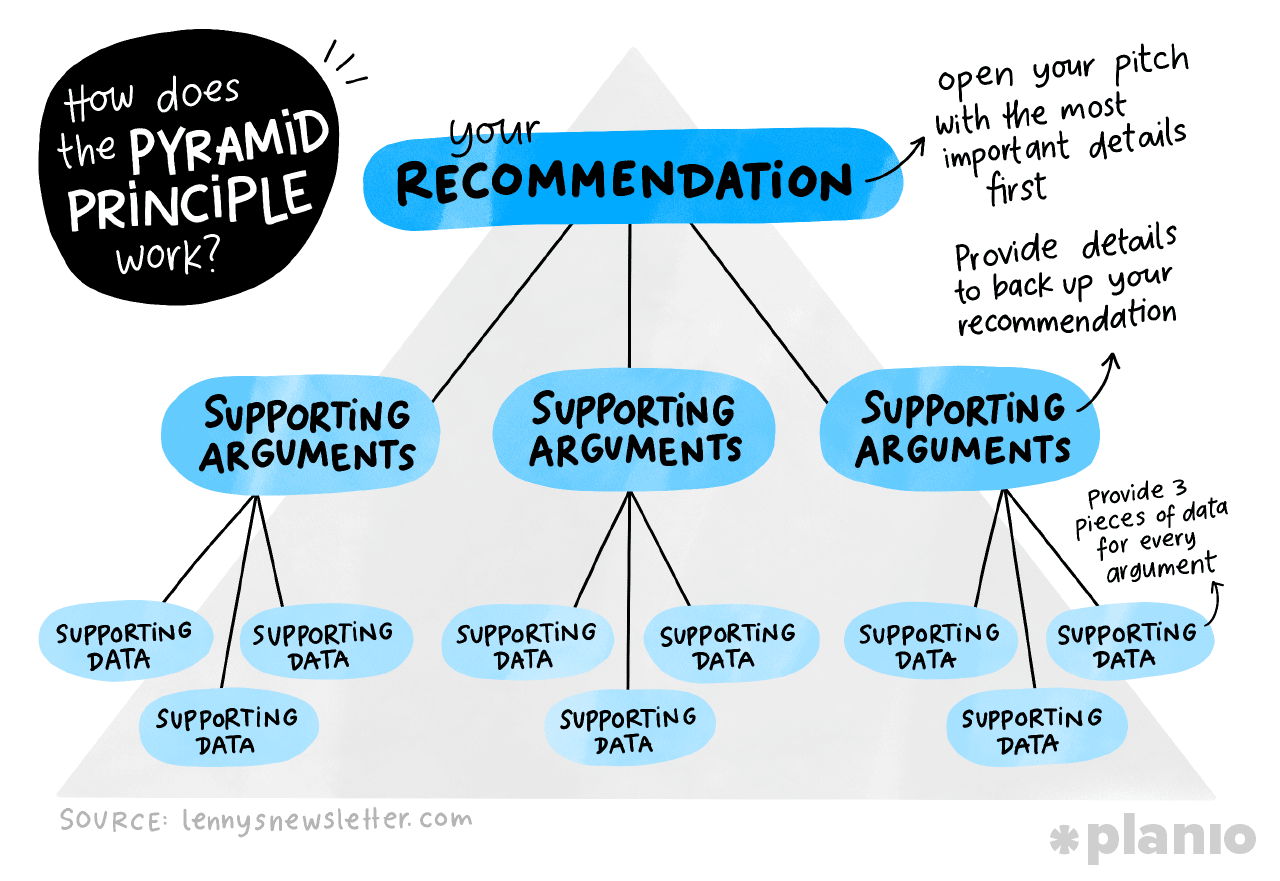
Think about the last Netflix movie you saw. It probably followed a storyline that built tension for hours before delivering the final battle. Movie directors do this to keep you on the edge of your seat.
It’s tempting to align your pitch with this strategy. But when it comes to effective pitches that follow the Pyramid Principle, the pitch starts with the spoiler.
From a pitch perspective, the pyramid principle looks like this:
1. Start with the recommendation/answer/ask up front
Open your pitch with the most important details first.
Busy executives want to hear your answer or solution to their question first. When a stakeholder or executive asks you “what should we do?” start your answer with, “You should do X” directly.
Only once you’ve concisely answered their question do you then progress onto delivering your supporting arguments.
A movie director keeps you on the edge of your seat, not a project manager. A good pitch starts with the spoiler.
2. Back up your pitch with a handful of supporting arguments
Next, provide a few relevant details to back up your recommendation.
At this stage, it’s important not to give in to the temptation of providing all the available details. You want to avoid overwhelming your audience with unnecessary information.
Pick out three key arguments that support your recommendations. Take care to organize and group supporting arguments together so it’s easier for your audience to digest and remember them.
Using the Pyramid Principle, every time you share an argument or solution you should summarize the next level of supporting ideas. The Pyramid Principle advocates that “Ideas at any level in the pyramid must always be summaries of the ideas grouped below them”.
3. Build trust in your arguments using supporting data
Finally, for every supporting argument, provide three pieces of supporting data.
But just throwing around stats and figures is no way to effectively pitch. Instead, make sure all your data and supporting arguments are organized in a logical manner. Here are a few examples:
- Time order: If there are events that form a cause-effect relationship, always share those ideas in time order.
- Structural order: Break a singular thought into digestible parts, making sure you’ve covered all of the key supporting parts.
- Degree order: Present supporting ideas in order of their importance, starting with the most and ending with the least.
When you select the three most relevant support points and present them using a logical pyramid principle structure, your pitch will become a powerful and effective communication tool.
As Barbara Minto says:
“You think from the bottom up, but you present from the top-down.”
Think of it as delivering the spoiler first followed by the supporting storyline and you’ve got the main concept of the Pyramid Principle.
Why does the Pyramid Principle work?
When you begin to structure your pitches to follow the Pyramid Principle you’ll find that executives and stakeholders become more responsive to your ideas and solutions. There are several reasons why the Pyramid Principle works so well for building trust and influence:
1. Executives want to see that you understand the business
Even when executives are given the latest statistics, reports, and expert opinions, they often still rely on how a business decision feels or sits with them.
If you can show executives that you’re aware of their needs by addressing what they want to hear first, you’ll be much more likely to hold their attention and build trust. As VP of change management, Tara Rethore explains:
“Executives need to be able to see that you understand how the project [or project management] itself drives a strategic business objective. This is what puts them at ease.”
Executives are busy people, they don’t have time to think about all the possibilities. Ultimately, they need clear and distilled information quickly to inform their next decision.
2. Executives don’t need (or want) too much explanation
Remember, your executives already understand the business. They don’t need fluff and low-level explainers–using these will only slow your pitch down and frustrate your listeners.
Executives are also used to thinking in a ‘top down’ manner and prioritizing the solution. Using the Pyramid Principle, you’re ultimately a lot clearer and more convincing in your communication which helps executives accept and understand your pitch.
3. Executives prefer direct communication
Ultimately, the Pyramid Principle is effective because it taps into the executive mindset and their usual process for making business decisions. When you’re direct, there’s less room for misunderstandings and miscommunications.
Clear communication also demonstrates you’re confident in your research and solutions and executives respect confidence. You’re also a lot more persuasive when you’re direct.
The Pyramid Principle provides a clear framework that’s easy for executives to relate to. And when you tie your pitch to overarching business objectives and keep it simple without swamping them with details, executives are more receptive to your ideas.
Executives and stakeholders will be more responsive to your ideas and solutions once you structure your pitches using the Pyramid Principle.
What does the Pyramid Principle look like in action?
It’s one thing to talk about pitches in an abstract sense. But the act of structuring information and trying to influence stakeholders is a whole other challenge.
Sometimes, the best way to really understand how to use a technique for yourself is to see it in action. So what are some examples of the Pyramid Principle being used?
To start, here’s one before and after example from former AirBnB product manager Lenny Rachitsky:

See how the PM is taking too long to set the scene and ‘burying’ the ask? By the time the stakeholder gets to the recommendation, they’ve lost the thread.
Now, here’s an example of the same ask, but formatted using the Pyramid Principle:
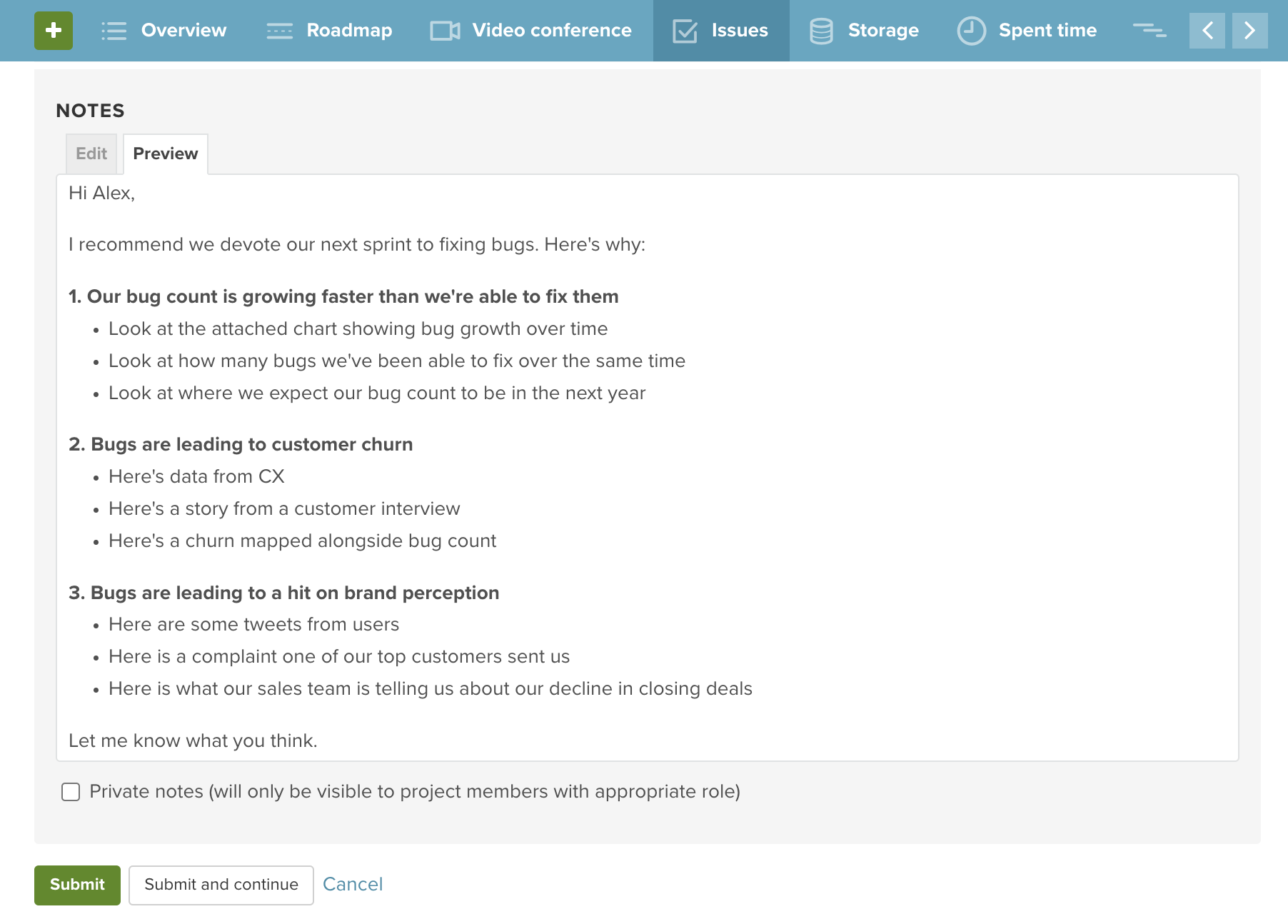
Boom! Suddenly, the ask is clear and each following argument ties directly to it and strengthens it. The pitch is not only a lot more reader-friendly, but it’s also way more persuasive.
How to structure the perfect project pitch using the Pyramid Principle
The Pyramid Principle might work for emails and simple recommendations. But what about larger project pitches that need nuance and flair to get your client or stakeholder excited?
Unfortunately, you can’t come into a pitch meeting with your guns blazing, throw out the Pyramid Principle, and leave. You still need to set the scene to a degree, particularly if you’re speaking to a new audience unfamiliar with your product or business.
To do that, let’s look at one other pitching framework called the SCR Framework.
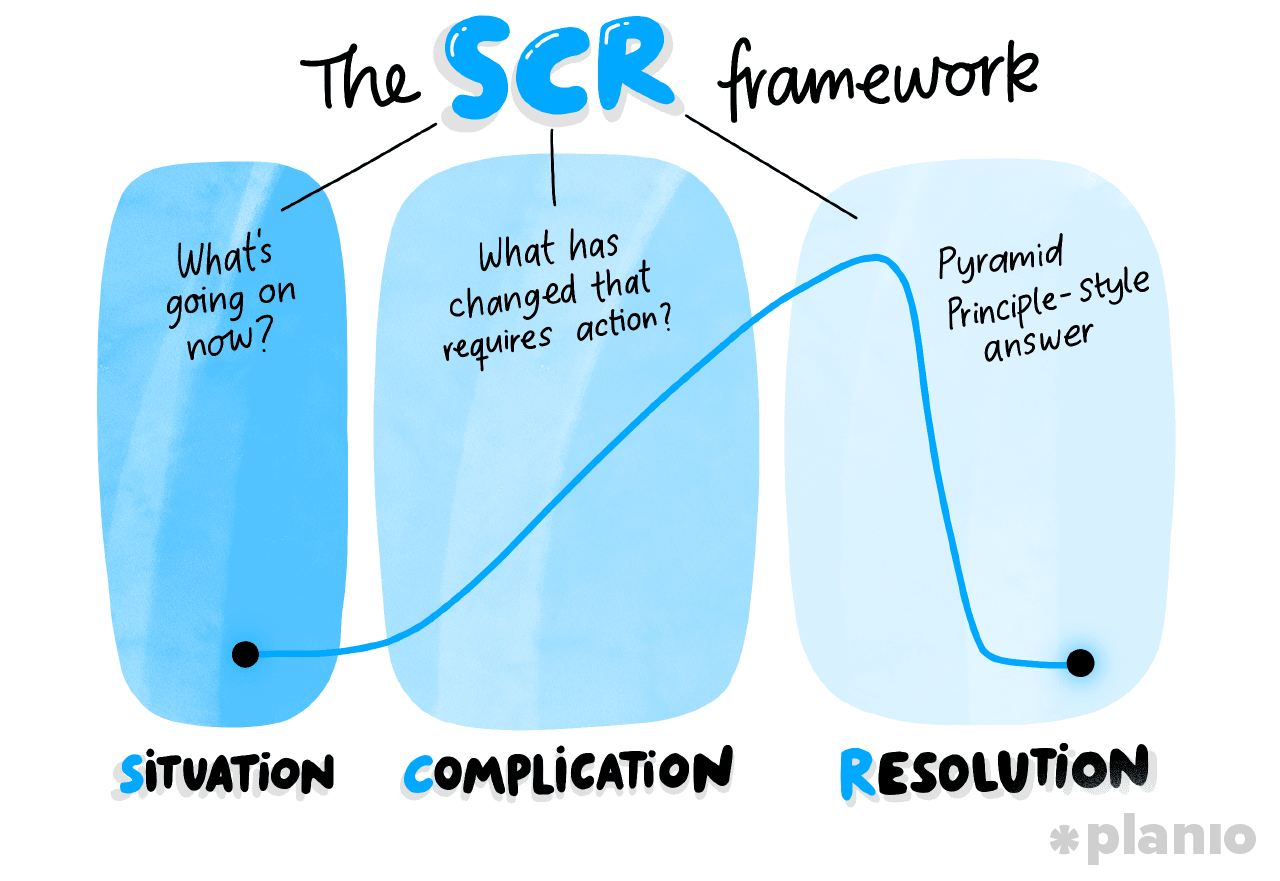
Situation: What’s going on now?
Inform listeners about the current business landscape. What’s going well and what isn’t going so well? What are the challenges and what are the successes? Asking yourself these questions will help you accurately inform listeners of what’s going on.
Complication: What has changed that requires action?
Next, directly inform listeners of the problem or issue that requires attention and action. Do this by increasing information, building context and explaining what’s changed and how. But always keep it solution-based so your listener doesn’t get bogged down in the details.
Resolution: Pyramid principle-style answer
Now you can get into your Pyramid Principle pitch.
Lead with your solution or recommendation and follow up with your supporting arguments. Presenting this way will keep your listeners interested and invested in the pitch before they zone out.
Think about any movie, TV show, or book. They all follow a dramatic storytelling structure where you gradually learn information and connect with the problems the protagonists are facing so you’re invested in the outcome.
To be persuasive, you need an argument that follows this flow. It doesn’t have to be reserved for pitches either. You can follow the SCR framework in strategy docs, emails, presentations, and anything else!
Pro tip: If you’re pitching to a small internal team that doesn’t need much background, move the resolution to the top (i.e., Resolution–Situation–Complication). This way, you’ll grab their attention from the outset and won’t bore them with too many details they don’t need to know about.
How to use the SCR framework outside of pitches
Whether you’re writing a strategy email or leading a team meeting, the SCR framework is a powerful form of communication. It helps you build context and nail why a task or project is so important in the first place.
So why limit it to pitch meetings? There are several places where you can use the SCR framework to help you be a better project manager:
- When crafting new ideas: Open a new doc and write down the SCR elements. Input your ideas according to the SCR framework so you already have the structure in place.
- In work emails (or any email!): Before you hit send, check to see if you’ve nailed the S and the C. Clearly distill your situation and complication before jumping into the resolution.
- When listening to presentations: Encourage speakers to follow this format. Alternatively, write down their presentation points in the SCR format while they talk to see if they’re missing any key parts
You’ll find that once you follow the SCR framework, your communication and your thought process will become clearer and more effective.
You’ll also likely save time as you won’t be worrying about how to structure that all-important work email. Instead, you’ll have a clear framework to follow, taking the stress out of how to communicate.
What if you don’t have time for an SCR/Pyramid Principle Pitch? Go with an elevator pitch instead
While the Pyramid Principle and SCR framework are powerful tools for persuasion, they still take time. But they’re not going to cut it when you’ve cornered that busy exec in the coffee room and they give you one minute to pitch your ideas.
When time is of the essence, it’s time to turn to the tried and tested Elevator pitch.
What is the elevator pitch style?
You’ve probably given an elevator pitch without realizing it. An elevator pitch or elevator speech is a window to share a brief summary of what you’re working on and why it matters.
Start by answering these questions:
- Who is it for? (Our Target Customer)
- What do they need? (Statement of the Need)
- What is the project? (Product Name and Category)
- What does it do? (Key Product Benefit, Compelling Reason to Buy and/or Use)
- Who’s the main competitor? (Primary Competitive Alternative)
- Why is this a better option? (Final Statement of Primary Differentiation)
So, all together, your elevator pitch will go something like this:
“For [customer] who [their need], the [project] does/provides/solves [key benefit]. Unlike [competitor], it will [key differentiator].”
Keep it short and keep it interesting. Only focus on the hits. You don’t need supporting arguments or data points yet. This pitch is just to get your foot in the door. Then, rework it as a Pyramid/SCR pitch for the real deal.
Best practices for mastering the art of pitching
Whether you’re going with the SCR/Pyramid principle style or an elevator pitch, what you say isn’t always as important as how you say it. Pitching is both an art and a science.
However you choose to structure your pitch, there are a few best practices you should always follow to ensure you nail every pitch:

1. Speak your audience’s language
Pitches sometimes fail because the project manager doesn’t align their communication with the executives. If you’re speaking to a room full of techies then feel free to use all the industry-specific jargon out there.
But if you’re speaking with stakeholders who don’t have all the background information, it’s important to use words they can relate to.
On a similar level choose the right tone. Depending on who you’re talking to and your company communication style, you may need to make your pitch more formal or alternatively more conversational.
2. Nail the first 90 seconds
The first 90 seconds of any pitch are vital for grabbing your audience’s attention. If you can hook them here, they’ll be more likely to engage with what you have to say later on. Use the elevator pitch and pique their interest right off the bat.
3. Get excited
Enthusiasm is contagious. When you’re enthusiastic about your offering or solution, listeners are much more likely to tap into that too and share your passion. Think about what makes you so enthusiastic about your solution and identify how you can best communicate that.
That way you’ll inspire and motivate listeners to take action. After all, no one wants to listen to a dull pitch where the speaker is obviously bored by their own suggestions.
4. Be your own case study
Nothing shows that your solutions work better than you being your own solutions advocate. If you can prove that your solution has already worked for you, others will buy into it. Who can provide a better solution to a problem that you encounter on a daily basis?
5. Plan ahead for how to handle questions
If you’ve kept your delivery clear and concise your audience hopefully has a clear idea of how your solution can help them. But if they want to dig into the details more, you’ll need to provide some solid answers to their questions.
Before you head into the pitch, make sure to be prepared to answer questions about the finer details of your proposal. That way you won’t be caught off guard when it comes to the questions round.
What happens next? How to nail your pitching every time
Pitching is an essential skill for project managers that want to move up in their careers. When you take the time to properly prepare a pitch that follows a clear framework, it’s much easier to communicate effectively with your listeners.
The key is to organize and structure your ideas into a framework before you present. That way when you’re in your flow presenting you won’t need to worry about forgetting any key details. Practice makes perfect and before you know it you’ll be able to plan out a pitch that follows the Pyramid Principle, SCR framework, or simply classic elevator pitch format.
Learn how to structure your pitch to be persuasive and exciting and you’ll be on the radar of every executive looking for their next team leader.
